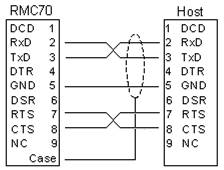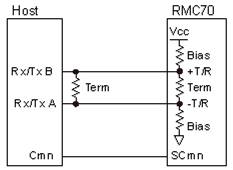
Fig. 1: Point-to-Point RS-232 Network

Fig. 2: Point-to-Point RS-485 Network
The RMC75S supports two network topologies: point-to-point and multi-drop. Which topologies are available depend on the line driver (RS-232 or RS-485) used. See Line Drivers: RS-232/485 for details on choosing the appropriate line driver.
Point-to-Point
Point-to-point means that exactly two devices are wired together. For the RMC, this means that there will be one RMC wired to one host. Both line drivers support point-to-point, as shown in Figures 1 and 2:
|
Fig. 1: Point-to-Point RS-232 Network |
Fig. 2: Point-to-Point RS-485 Network |
Figure 2 shows biasing and termination. Termination and biasing can be left out of networks at the expense of maximum cable distance and noise immunity. See RS-485 Termination and Biasing for details.
Multi-Drop
Only RS-485 supports multi-drop. Multi-drop is the connecting of multiple slaves with a single master. Slaves should be chained together. Neither a star topology nor a chain with long stubs (wires from the main chain to the device) should be used. These topologies will cause excessive ringing on the network and unreliable data transmission.
The number of devices that can be connected to the network is dictated by the number of unit loads that each represents. According to the TIA/EIA-485-A specification, there can be a maximum of 32 unit loads connected to a single network. Each RMC represents unit load for a total of 124 RMCs on the network, assuming the host is a unit load.
Figure 3 shows a typical multi-drop chain:
|
Fig. 3: Daisy-Chained RS-485 Network |
Note:
Termination should only be located at the extreme ends of the network:
Figure 4 shows one host with two RMC controllers in a daisy-chained two-wire RS-485 configuration:
|
Fig. 4: Two-Wire Multi-drop RS-485 Network |
See Also
Copyright © 2025 Delta Computer Systems, Inc. dba Delta Motion